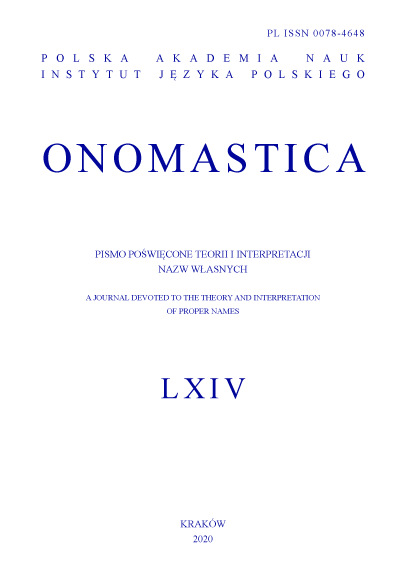Streszczenie
Celem artykułu jest omówienie wybranych formalnych i pragmatycznych aspektów austro-węgierskiej wojskowej polityki nazewniczej w ostatniej ćwierci XIX i na początku XX w. We wstępnej części nakreślono proprialny status nazw jednostek wojskowych jako składnika chrematonimii wojskowej oraz podjęto próbę szkicowego ulokowania omawianych nazw na klasyfikacyjnej mapie chrematonomastyki. Krótko omówiono ogólne historyczne i terminologiczne tło austro-węgierskiego nazewnictwa jednostek wojskowych. Nakreślono najważniejsze pojęcia teorii polityki nazewniczej. Prezentacja materiału obejmuje nazwy zawarte w schematyzmach austro-węgierskich sił zbrojnych oraz napisy na papierowych pieczęciach (Verschlussmarken). Na podstawie materiału wskazano na polimorfizm omawianych nazw, polegający na tym, iż zależnie od kontekstu (w tym tekstu ciągłego, w którym pojawiają się nazwy) obligatoryjne i fakultatywne elementy nazw realizowane mogą być na różne sposoby i w różnych konstrukcjach składniowych. Zaproponowano też dwa główne modele nazewnicze organizujące składniową strukturę omawianych nazw. Nakreślono ortograficzne i składniowe zasady numeracji jednostek oraz włączania do nazw jednostek nazw geograficznych oraz nazw patronów i „właścicieli” pułków (Inhaber). Omówiono znaczenie i pisownię określeń cesarko-królewski oraz cesarski i królewski (k.k. = c.k.; k.u.k. = c. i k.).
Bibliografia
Bator, J. (2005). Wojna galicyjska [War in Galizien]. Kraków: Libron.
Breza, E. (1998). Nazwy obiektów i instytucji związanych z nowoczesną cywilizacją (chrematonimy) [Names of objects and institutions related to the modern civilisation]. W: E. Rzetelska-Feleszko (red.), Polskie nazwy własne. Encyklopedia [Polish proper names. Encyclopedia] (s. 343–361). Warszawa–Kraków: Towarzystwo Naukowe Warszawskie — Instytut Języka Polskiego PAN.
Dunaj, B. (2007). Teoretyczne problemy onomastyki sportowej. Sposoby identyfikacji klubów [Theoretical aspects of the onomastics of sports. Ways of identifying sport clubs]. W: A. Cieślikowa, B. Czopek-Kopciuch, K. Skowronek (red.), Nowe nazwy własne. Nowe tendencje badawcze [New proper names. New research trends] (s. 489–494). Kraków: PANDIT.
Gałkowski, A. (2007). Socjoideonimy a chrematonimy — miejsce nazw organizacji i inicjatyw społecznych w dynamice onimicznej języka [Socioideonyms and chrematonyms — the status of the names of social organisations and activities in the onymic dynamics of the language]. W: A. Cieślikowa, B. Czopek-Kopciuch, K. Skowronek (red.), Nowe nazwy własne. Nowe tendencje badawcze [New proper names. New research trends] (s. 495–508). Kraków: PANDIT.
Gałkowski, A. (2011). Chrematonimy w funkcji kulturowo-użytkowej. Onomastyczne studium porównawcze na materiale polskim, włoskim i francuskim [Chrematonyms in the cultural-functional context. An onomastic comparative study based on Polish, Italian and French resources]. Wyd. 2. Łódź: Wydawnictwo Uniwersytetu Łódzkiego.
Górnowicz, H. (1979). Nazwy własne polskich jednostek wojskowych [Proper names of Polish military units]. Poradnik Językowy, 8, 369–386.
Karamańska, M. i Młynarczyk, E. (2018). Językowy obraz troski o II Rzeczpospolitą utrwalony w nazwach stowarzyszeń [A linguistic image of concern over the Second Polish Republic as preserved in association names]. Annales Universitatis Paedagogicae Cracoviensis. Studia Linguistica, 13, 13–24.
Karamańska, M. i Młynarczyk, E. (2019). Komponenty eksponujące cechę żeńskości w nazwach stowarzyszeń II Rzeczpospolitej [Components exposing the feminine quality in the names of associations in the Second Polish Republic]. Annales Universitatis Paedagogicae Cracoviensis. Studia Linguistica, 14, 67–78.
Kosyl, Cz. (1993). Chrematonimy [Chrematonyms]. W: J. Bartmiński (red.), Współczesny język polski. Encyklopedia kultury polskiej [The modern Polish language. An encyclopaedia of Polish culture] (t. 2, s. 440–444). Wrocław: Wiedza o Kulturze.
Kucała, M. (1967). Co już jest, a co jeszcze nie jest nazwą własną [What is already a proper name and what is not]. Onomastica, 12, 153–161.
Kułakowska, M. (2018). Nazwy bractw rycerskich jako element budowania wizerunku grupy rekonstrukcyjnej [The names of the brotherhoods of knights as a building block in the image of a historical reenactment group]. Słowo. Studia językoznawcze, 9, 68–83.
Lubaś, W. (1983). Próba socjolingwistycznej definicji nazwy terenowej [An attempt at creating sociolinguistic definition of a name of uninhabited geographical feature]. W: K. Rymut (red.), Geografia nazewnicza [Geography of names and naming] (s. 19–26). Wrocław–Warszawa–Kraków–Gdańsk–Łódź: Zakład Narodowy im. Ossolińskich.
Młynarczyk, E. (2019). Tendencje nazwotwórcze w chrematonimii społecznościowej II Rzeczypospolitej (na przykładzie nazw stowarzyszeń) [Trends related to the creation of names in the social chrematonymy of the Second Polish Republic (based on the names of associations)]. Onomastica, 63, 209–226.
Nowakowski, T. (1992). Armia Austro-Węgierska [The Austro-Hungarian Army]. Warszawa: FENIX.
Włoskowicz, W. (2015). Trójelementowy model znaczenia onimicznego i pojęciowy model onomastykonu [The triple model of onymic meaning and the conceptual model of onomasticon]. Onomastica, 59, 57–76.


